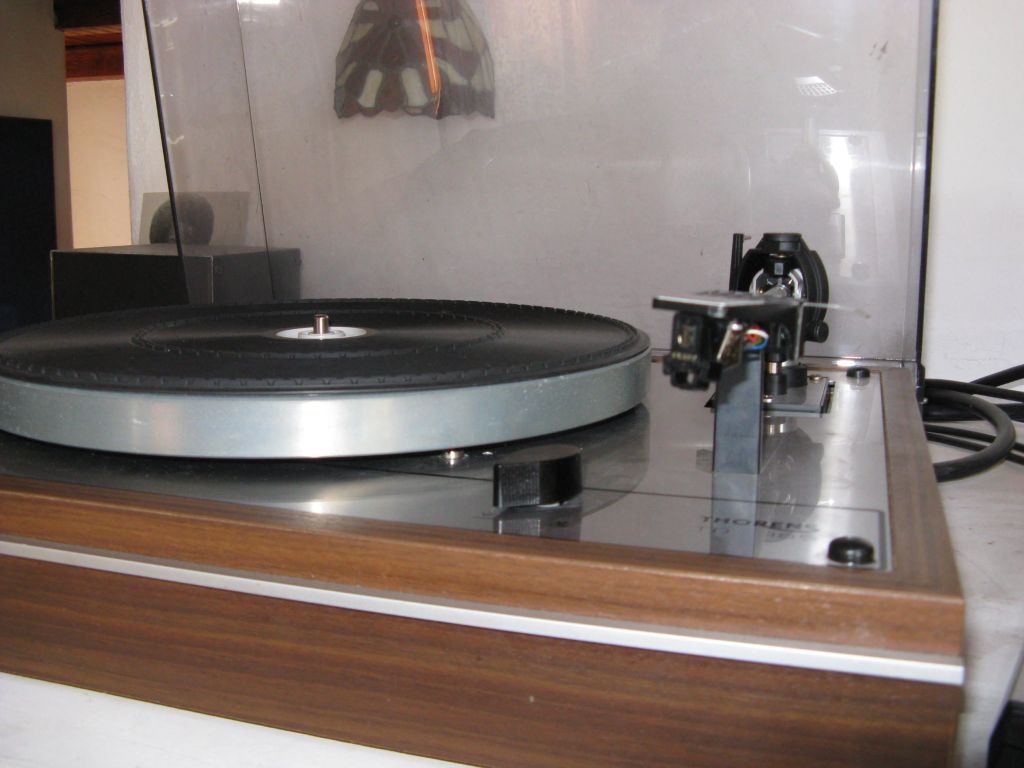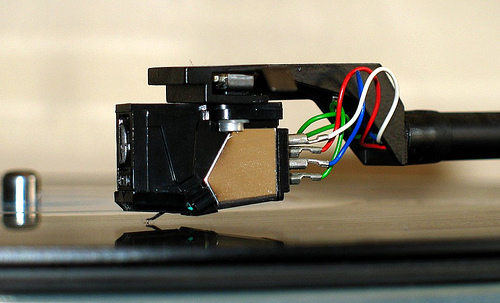Putting together a minimal HiFi system means choosing a source, an amplifier, and a couple of loudspeakers. The source may also be a turntable – why not?
Really? Today?
Well, yes. Maybe you still have one at home, maybe you think about it as a piece of antiquity but it can be exhumed with fine results. You may consider an old turntable as obsolete. On the contrary, it may sound really better than a middle priced CD player (the cheap ones are easily defeated). You don’t believe it? Come visit me for a listening test…
Buy used safe?
If you have an old turntable you will certainly have to readjust it and tune it up. No complicate job, you just need patience. Internet is a very good source of information. A suspended table like Thorens and Linn has adjustable springs that achieve the isolation and allow the platter to rotate on a perfectly horizontal plane, if well tuned (picture below form The Analog Dept).

The Thorens suspension from the Analog Dept
One of the first things to do on such turntables is checking the suspension’s conditions. Gently hitting with a finger the platter close to the rotation center will tell us if the platter can bounce vertically at least four or five times before stopping. If this doesn’t happen, the suspension system will have to be dismantled and cleaned, using particular care with the springs, that can be replaced, at worse. They will have to me mounted back so that the platter will be perfectly horizontal and free of bouncing vertically. The platter rotation must be noiseless and smooth. The bearing shaft around which the platter rotates must be scratch free, it must show no play and has to be carefully lubricated. We can use lube oil for sewing machines oer weapons. Even some 10 W40 motor oils are good for the job (i.e. Castrol GTX).
A good candidate for our analog source would be a belt-driven turntable. Direct drives, some illustrious exceptions aside, bay turn out less sharp and long-living, also more complicated to repair. The belt transfer the motor’s rotation to the platter’s support (Thorens TD-160 in the picture at left); its elastic properties don’t last forever, if the belt is several years old it is better to replace it (a modest expense). The belt must be of the same size as the original.
The cartridge too will have to be almost certainly replaced. It is paramount to pick the right one among brands like Grado, Ortofon
, Goldring
, Audiotechnica
, according to the turntable’s and tonearm’s performance level (starting around the 50 euro price tag). This is a very important rule which is valid for the HiFi system as a whole: it is useless to put together units of different price (and performance) categories; the final result will just be the top performance of the lesser unit (the strength of a chain is the strength of the weaker ring).
It is a lot better to make sure the cartridge is working with the tracking force it has been design for (Internet has all necessary infos). If the tacking force is too low we will lose some information during playback, to the extent of degrading the sound; it it is too high (=heavy), we will reinforce the low frequencies resulting in an unbalanced sound, besides rapidly wearing out both stylus and records. Many cartridges have replaceable styli, sometimes records are not replaceable. During playback, the stylus should be vertical and the tonearm horizontal. A tonearm dipping toward the cartridge may be sometimes acceptable, the contrary is not. A defective or cheap tonearm can be replaced with a better one. We can save this upgrade for the future if we want to save money. Sometimes, matching the right tonearm to a turntable can give enormous sound quality improvements, revealing the hidden potential of our turntable. Therefore, a used turntable, even a very cheap one, but well-built at his time, can still surprise with its sound quality today!
A turntable must be on a perfectly horizontal rigid plane. Ideally, marble of concrete would be great. Thick glass would also suffice, provided it’s not lying on a vibrating surface. The best solutions are wall mounts. Ah, much important, too: not all today’s amplifiers have a phono input for turntables. Plugging a turntable to normal line inputs results in unbearable noise – avoid that! Some project models come with a built-in phono stage so you can plug them to a plain line input. Otherwise, you should get you an external phono stage; in this case, you better assess the actual performance level of your turntable/tonearm/cartridge system: up to a certain degree, it is better to invest your money on a simple integrated amp fitted with a dedicated phono input (some from Nad, Cambridge and Rotel; Audio Analogue, Unison Research, at higher quality). An external phono stage is advisable only beyond certain performance levels or if we just can do without the “phono-less” amplifier we have/want.
A good turntable can certainly be found in the used market. They are practically indistructable or easy to repair. If well tuned thay can give big, great satisfaction. It is also important to understand that a turntable can be greatly improved with time by upgrading step by step parts like the cartridge or the tonearm, the ones affecting the sound quality most. Other upgrades would be a better platter mat made of felt, cork or other dampening material; you could add a graphite clamp or weight on the record, which would smooth vibrations; sometimes the phono cables can also be improved, or using a better external phono stage than the one inside our amp. In summary, a turntable will get better with time and its sound quality is far superior to all the noise we are used to nowadays. Listening is believing..,
Exposing the VTA myth on tnt-audio.com
My experiences with the vinyl format, by Arvind Kohli, on tnt-audio.com
Thorens suspensions on theanalogdept.com
Tonearm alignment on theanalogdept.com
Pearl Jam: Spin the black circle (Vitalogy, 1994)



